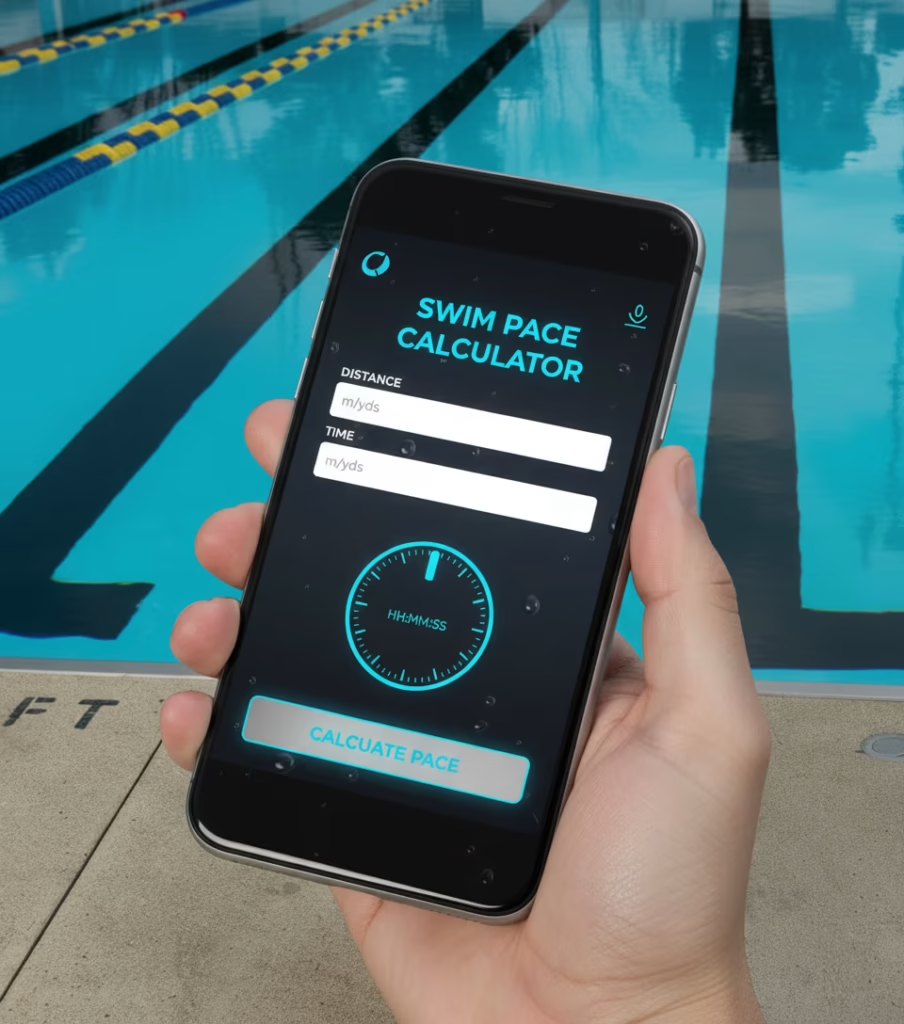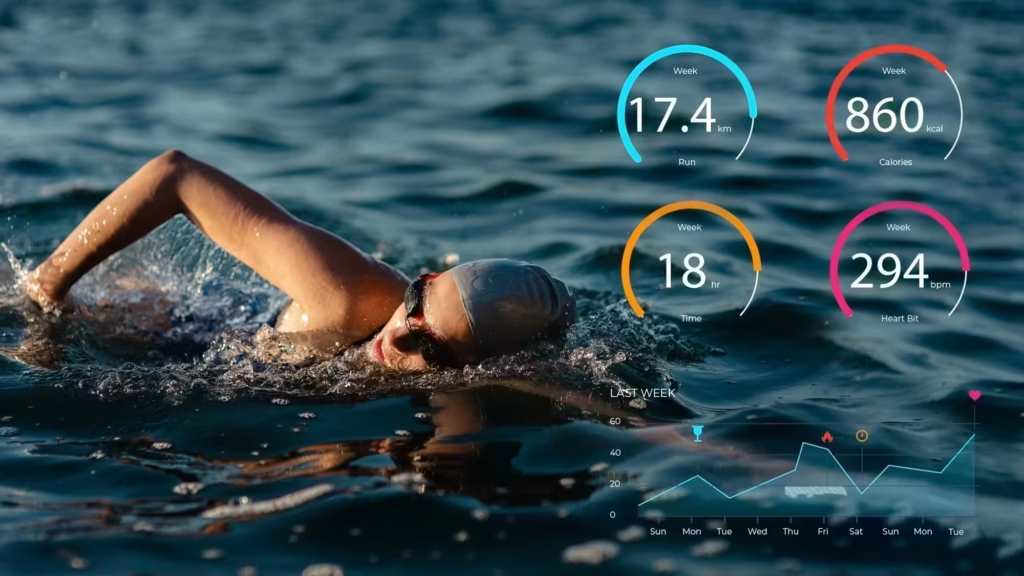Whether you are a competitive swimmer, a triathlete or mere fitness enthusiast, knowing your swim pace is important in the context of enhancing performance and achieving your objectives. The Swim Pace Calculator allows you to speedily transform swim times, examine your speed and develop successful exercises. In this blog we are going to discuss how to use the calculator, the science behind the calculation in this calculator and how you can use the information to apply to your training.

Understanding the Importance of Swim Pace Calculator
Swim pace calculator, is one of the most important measurements for swimmers of all levels, often measured in minutes per 100meters or 100 yard swim time. It helps you:
- Monitor progress: Monitor the way you get better.
- Maximize training: Structure exercises based on pace goals of endurance, speed or recovery.
- Plan race strategy: Estimate the finish times and construct pacing plans of events in 100 yards to open-water marathons.
- Compare Performances: Compare yourself with other swimmers or elite swimmers regardless of the length or measurement unit of the pool.
The Core Formula
The fundamental formula for calculating swim pace is:
Pace = Total Time ÷ (Total Distance ÷ 100)
For example, if you swim 1,500 meters in 30 minutes, your pace is 2:00 per 100 meters.
Units and Pool Configurations
- Meters vs. Yards: Most pools are 25m, 50m or 25yd long. Since 1yd=0.9144m, a yard time is typically quicker- lap distance less and more turns.
- Time Converter (25yd 100m): Convert 100yd Time into 100m Time: To convert 100yd into 100m time multiply by 1.1 since 100m is approximately it takes 10.
Multi-Mode Calculators
Modern swim pace calculators offer three main modes:
- Calculate Pace – Use your time and distance in order to determine the pace per 100m or per yard.
- Calculate Time – Select the distance and the desired pace and calculate the total time to use to swim.
- Distance Calculation– Enter the pace and the time you have to calculate the distance you can swim.
The Basics of a Swim Pace Calculator
A Swim Pace Calculator is a web-based app or app that allows it to be simple to estimate your average pace, change times in yards to meters and set up exercises. Key features include:
- Input Flexibility– Enter distance and time in meters, yards or HH:MM: SS.
- Output Settings – Receive rate per 100 m or 100 yd, between times, and speed expressed in any of the following units: km /h.
- Conversion Tools -Swim times can be converted instantly into and out of yards and meters, or pool lengths.
- Training Zone Integration – There are calculators that provide training zones depending on your pace or Critical Swim Speed (CSS).
Key Metrics and Considerations
Accurate Data Input for Precise Calculation
- Consistency: Always use the same units (meters or yards) for both distance and pace.
- Time Format: Enter time in HH:MM: SS for accuracy.
- Stroke Type: Freestyle is the default, but pace varies for backstroke, breaststroke, and butterfly.
Interpreting Swim Pace Results
- Pace per 100m/yd: Standard for comparing performances.
- Split Times: Useful for interval training and race analysis.
- Speed (km/h or mph): Helpful for triathletes and open water swimmers
Applying Results to Training Strategies
Developing Goal-Oriented Swim Plans
- Set Realistic Targets: Use your current pace to set achievable goals for upcoming races or training cycles.
- Interval Training: Design sets (e.g. 10x100m at threshold pace) to target specific adaptations.
- Progress Tracking: Regularly recalculate your pace to monitor improvement and adjust training zones.
Performance Analysis Through Temporal Factors
- Fatigue Management: Use pace data to avoid overtraining and ensure adequate recovery.
- Negative Splits: Practice swimming the second half of a set or race faster than the first to build endurance and pacing skills.
Environmental Factors in Swim Training
Swim pace converter is influenced by more than just fitness. Key environmental factors include:
- Water Temperature: Cold water can slow pace due to muscle inefficiency; warm water can cause fatigue.
- Pool Crowding: Disrupts rhythm and can slow pace.
- Open Water Conditions: Currents, waves, and navigation challenges typically add 5–10 seconds per 100m compared to pool times.
- Pool Length: More turns in a 25-yard pool can lead to faster times due to push-offs.
Tailoring Workouts Using Advanced Applications
Integrating Swim Pace with Training Zones
- Critical Swim Speed (CSS): Use your 200m and 400m time trials and calculate your CSS and use them to determine your zones of training.
- Zone-Based Training: Design the workouts based on intensity levels, such as recovery, aerobic, threshold and VO 2 max to be most adaptive.
Adapting Swim Pace for Open Water Swimming
- Learn to adjust to conditions: You should add extra time to your pace in the pool to be able to adjust to the factors of the open water.
- Train sighting: Involve navigation exercises to enable you to maintain the pace during swimming in open waters.
Leveraging Technology in Swim Pace Calculation
- Wearable Devices: Most smartwatches and swim trackers are automatic with their insurance calculating pace and uploading them to online calculators, providing more in-depth analysis.
- Data Logging: See how you are progressing, contrast it with standards and optimize your training program.
Common Mistakes to Avoid
- Mixing Units: It is necessary to check on the type of unit used always, whether it is meters or yards because the wrong unit may give inaccurate calculations.
- Inclusion of Rest Intervals: In computing your pace, you should include only your swimming time and not rest intervals.
- Ignoring Environmental Factors: Customize your expectations and training According to the conditions you are in (you are in a pool or open water) and consider the temperature of the water (as well as other factors).
Conclusion and Final Tips for Swimmers

A Swim Pace Calculator is a necessary application among swimmers and triathletes who desire performance improvement. With the knowledge of your pace, time conversion and application of both in training, you can set wiser goals, track progress and record new personal bests. Always remember to consider the environmental factors, use the same unit and update the pace data frequently to train most effectively.
Ready to take your swimming to the next level? Use our Swim Pace Calculator to unlock your full potential in the pool or open water!
FAQs
What is a swim pace calculator?
A swim pace calculator is an online application or tool that can assist you in getting to know your average per 100 meters/yards swimming pace. It is capable of converting the time of your swim between different units and allows you to design a workout according to your present fitness status.
How can I use swim pace metrics to improve my training?
Your calculated pace will help you set training zones, create interval sets as well as measure your progress. You can tailor your exercises to that speed to achieve a certain adaptation endurance, speed or recovery.
Are there specific drills to enhance swim pace?
Yes! You can use interval training, negative split sets and technique exercises, including the stroke rate, the body position and breathing, to systematically increase your pace in the pool as you go.










